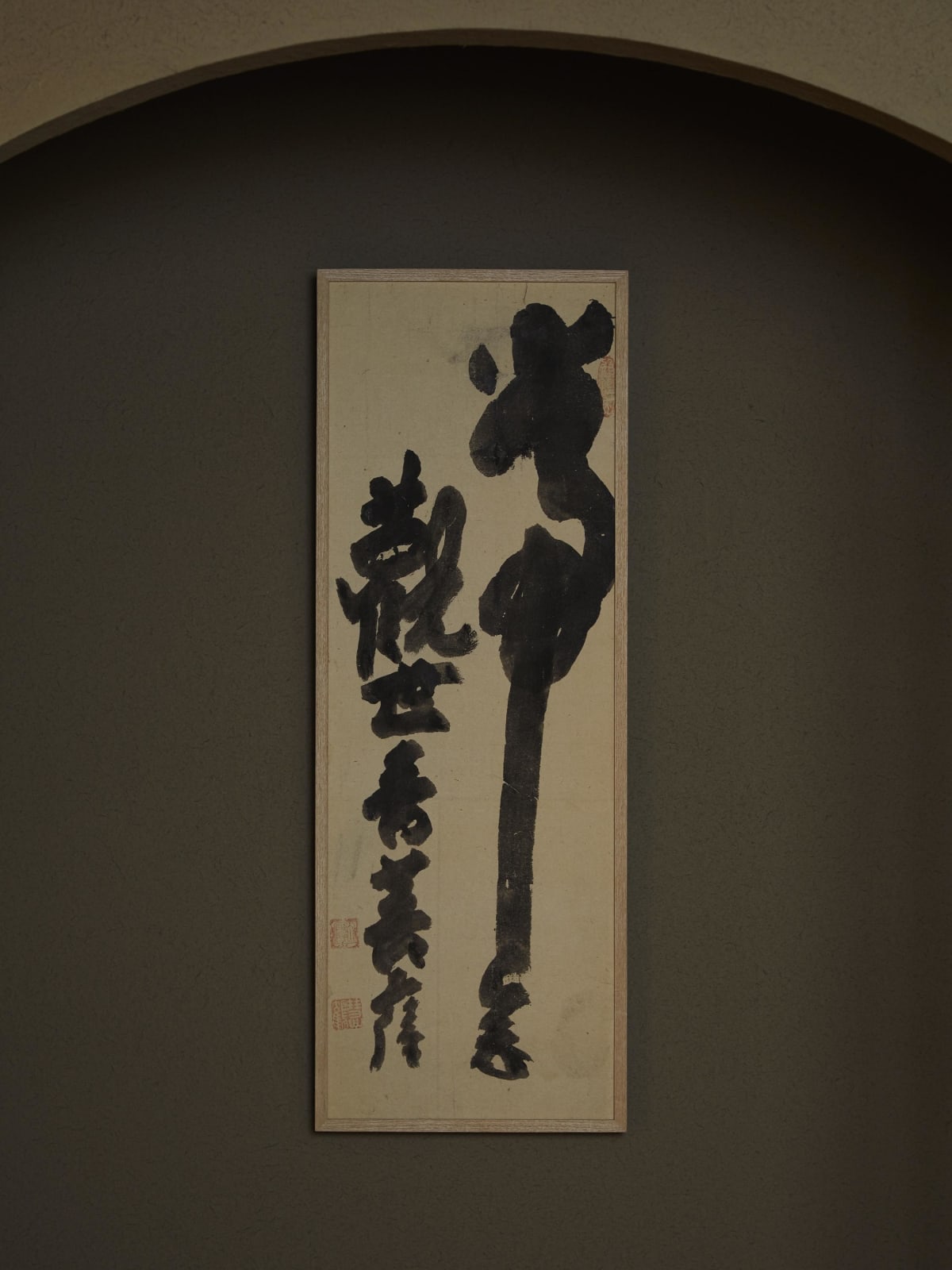Hakuin Ekaku (1685–1768)
Jōnen Kanzeon Bosatsu
Ink on paper, framed
Seals: Kokan’i, Hakuin, Ekaku
67.2 x 23 cm
69.2 x 25 cm (overall)
Seals: Kokan’i, Hakuin, Ekaku
67.2 x 23 cm
69.2 x 25 cm (overall)
Further images
Hakuin Ekaku devoted himself to the teaching of Rinzai School of Zen to a wide variety of people ranging from daimyo to commoners. For this didactic purpose, he highly recommended the Enmei jikku Kannon-kyo, a short sutra of only ten sentences which discusses in plain expressions about becoming a believer of Kanzeon Bosatsu, or Avalokiteshvara Bodhisattva. This China-originated sutra widely spread among the Japanese, thanks to Hakuin’s effort of writing the Enmei jikku Kannon-kyo reigenki and explaining the significance of the sutra. The words of the present scroll, “Jonen kanzeon Bosatsu (Always call upon the name of Kanzeon Bosatsu),” derive from this sutra: “Chonen Kanzeon bonen Kanzeon (Call upon the name of Kanzeon in day and night).” It is said that Hakuin brushed and distributed these words to his audience during his Kannonko lecture.
The most distinctive feature of Hakuin’s writings of these words is the structure of the character “Jo,” whose elongated vertical stroke resembles to the stick or the tail of a dragon. The brushwork is solid and powerful, creating an impression of an ink painting. This work embraces most typical Hakuin features, and can be enjoyed both as a calligraphic piece and a painting. Its compact size enables display at almost any place, which echoes to its content: “Always call.”
Hakuin Ekaku (Zen priest; 1685–1768)
Also known as Shinkidokumyo-zenji, Shoshu-kokushi (posthumous Buddhist names).
Suruga-born mid Edo period Rinzai School Zen priest. Became a disciple of the Zen master Tanrei Soden at Shoin-ji Temple, and was given the Buddhist name ‘Ekaku’. Traveled to a number of temples to study under different Zen masters, including Bao Soshun at Zuiun-ji Temple in Mino, Itsuzen at Shoshu-ji Temple in Iyo, and Shotetsu at Eigan-ji Temple in Echigo. Became the chief abbot of Myoshin-ji Temple in 1718. His disciples include the Zen masters Torei Enji and Suio Genro. Played a vital role in reviving the declining Rinzai School, and spread Zen Buddhism among wide public.
The most distinctive feature of Hakuin’s writings of these words is the structure of the character “Jo,” whose elongated vertical stroke resembles to the stick or the tail of a dragon. The brushwork is solid and powerful, creating an impression of an ink painting. This work embraces most typical Hakuin features, and can be enjoyed both as a calligraphic piece and a painting. Its compact size enables display at almost any place, which echoes to its content: “Always call.”
Hakuin Ekaku (Zen priest; 1685–1768)
Also known as Shinkidokumyo-zenji, Shoshu-kokushi (posthumous Buddhist names).
Suruga-born mid Edo period Rinzai School Zen priest. Became a disciple of the Zen master Tanrei Soden at Shoin-ji Temple, and was given the Buddhist name ‘Ekaku’. Traveled to a number of temples to study under different Zen masters, including Bao Soshun at Zuiun-ji Temple in Mino, Itsuzen at Shoshu-ji Temple in Iyo, and Shotetsu at Eigan-ji Temple in Echigo. Became the chief abbot of Myoshin-ji Temple in 1718. His disciples include the Zen masters Torei Enji and Suio Genro. Played a vital role in reviving the declining Rinzai School, and spread Zen Buddhism among wide public.







